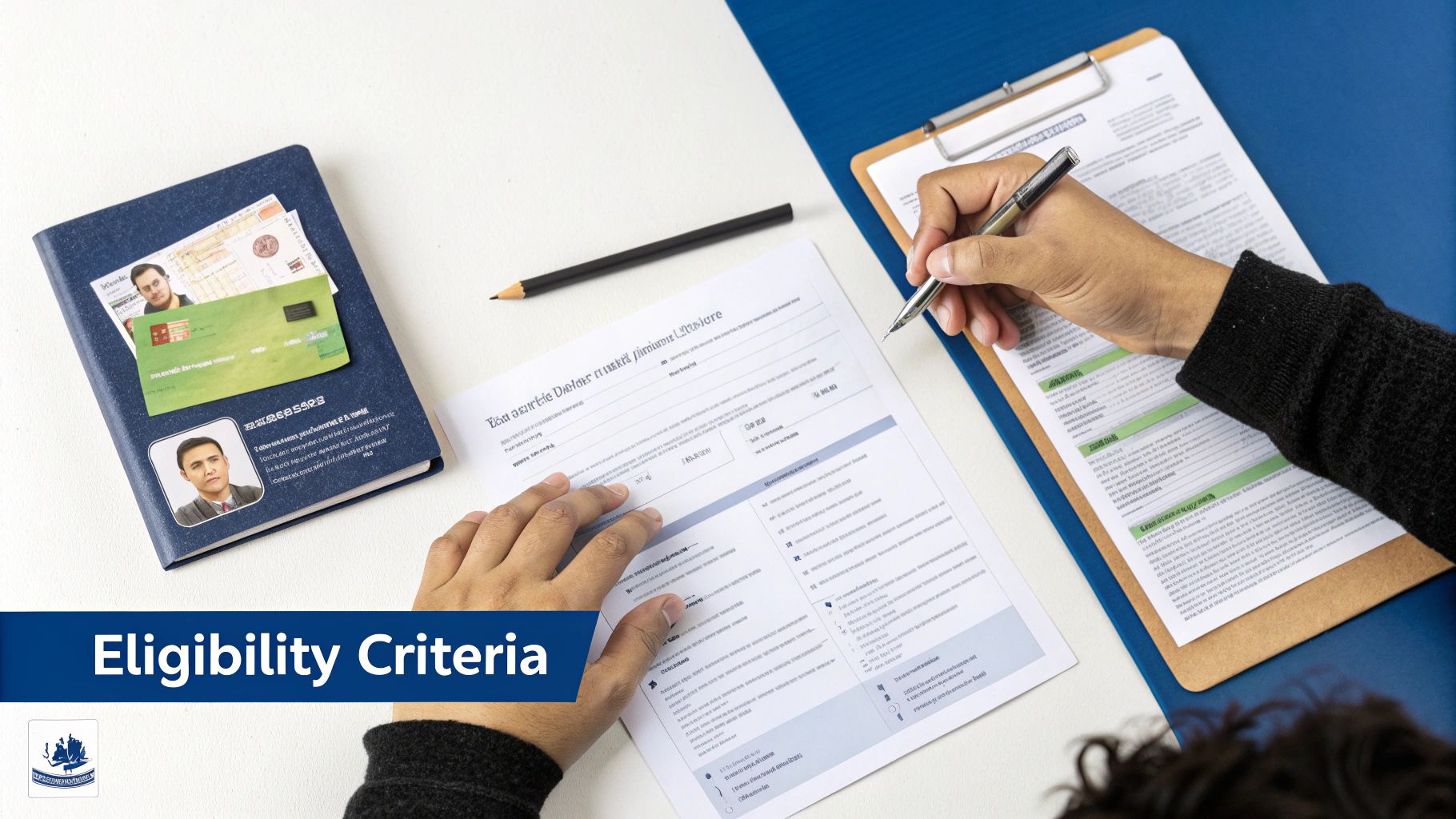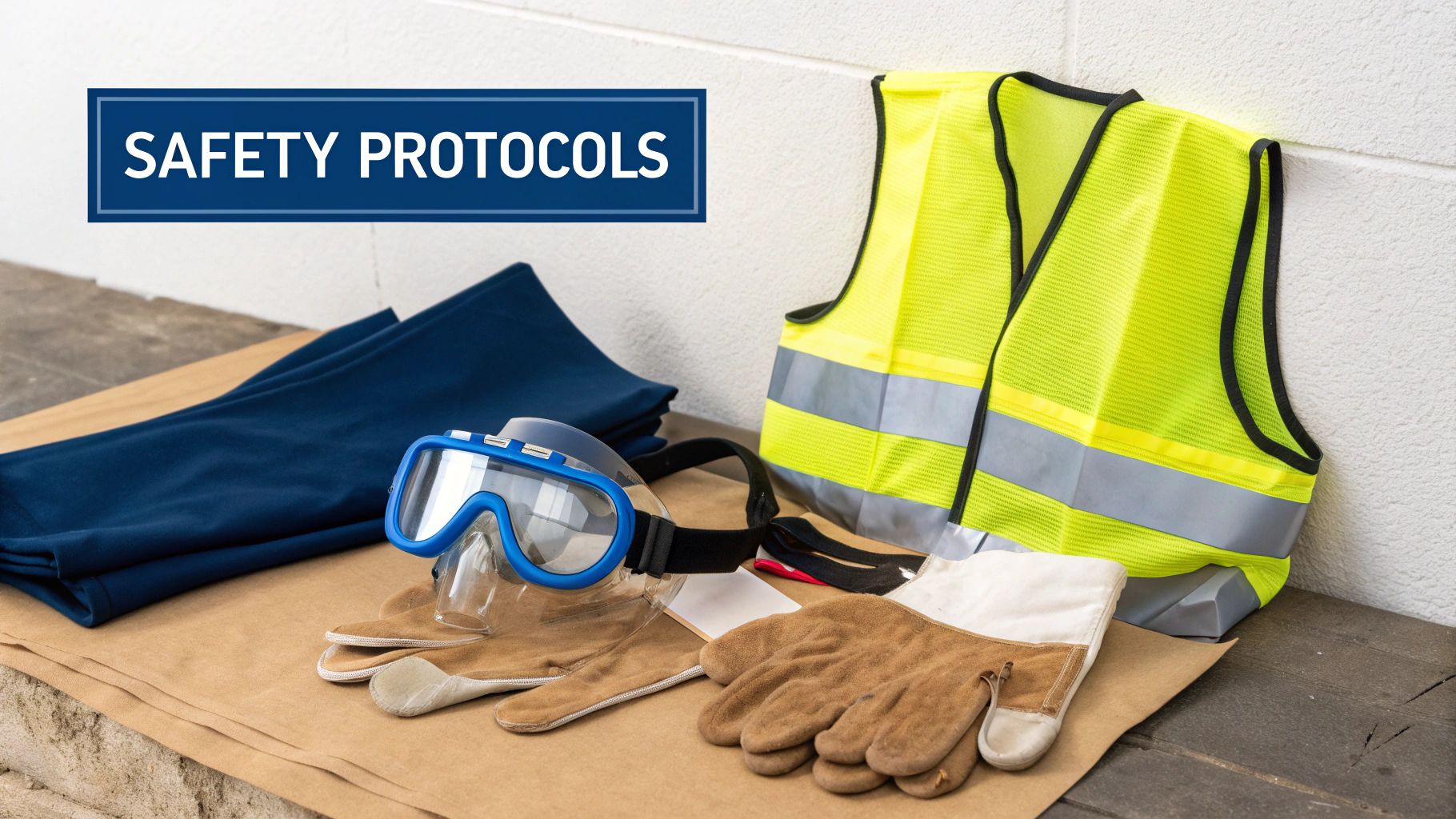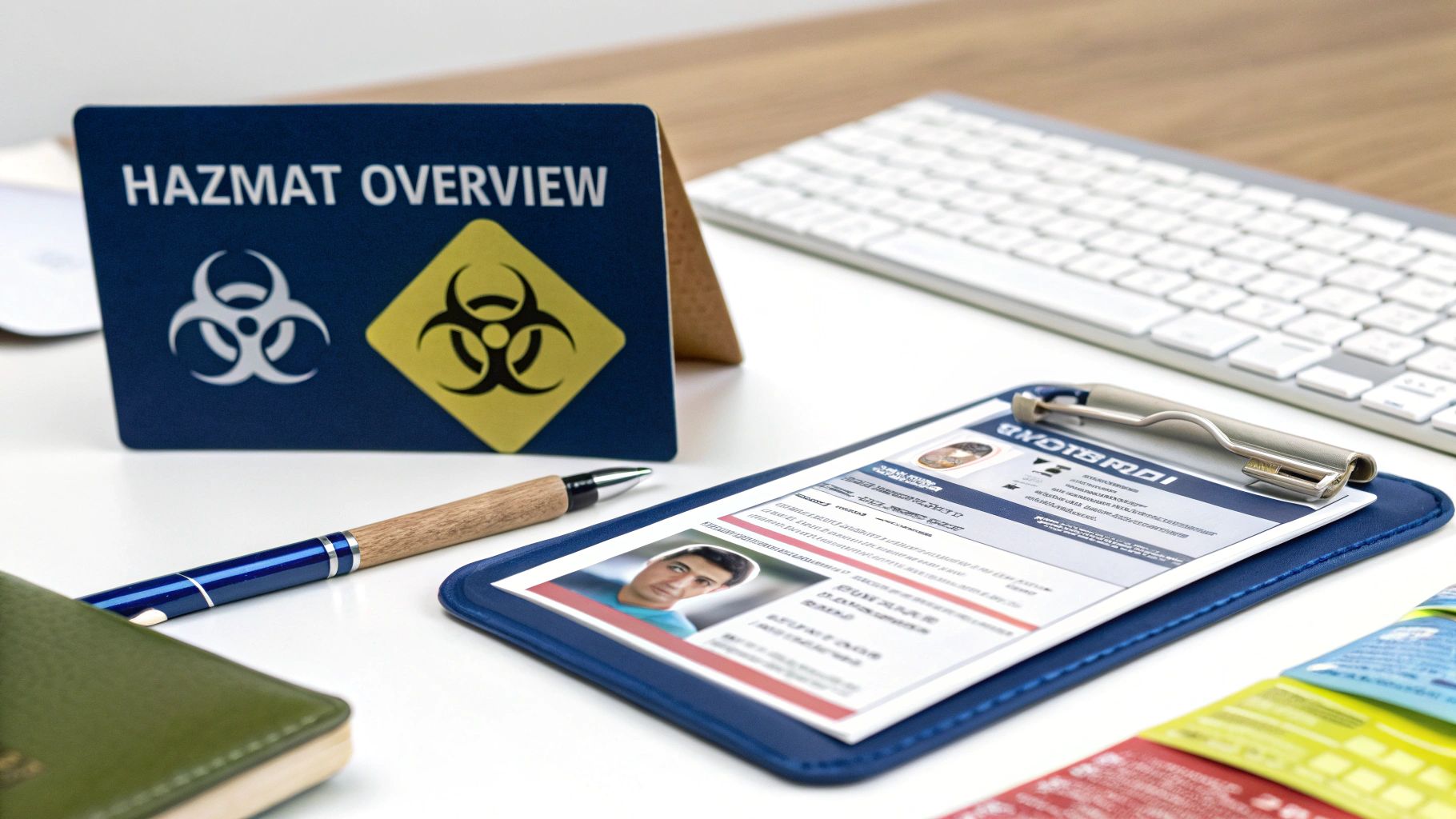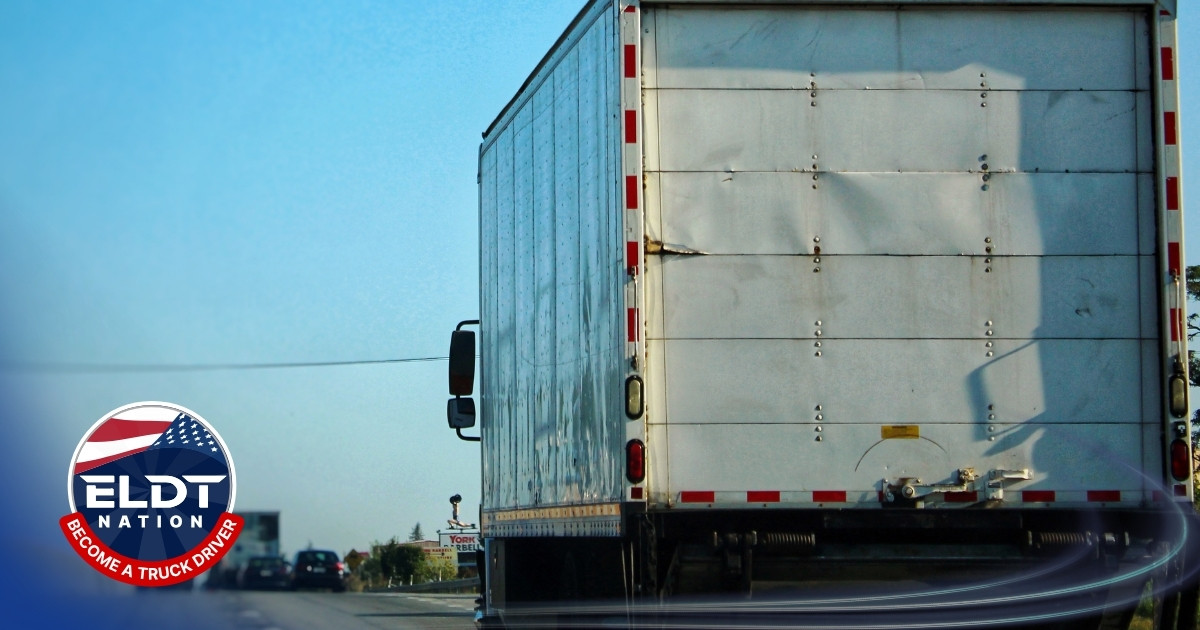Your Guide to Hazmat Endorsement Training
If you want to haul more kinds of freight and get paid better, you've probably heard about the hazmat endorsement. So, what is it?
Simply put, hazmat endorsement training is a safety course you have to take before you can legally haul hazardous materials. It’s a special add-on to your CDL that proves you know how to handle these loads safely.
What Is a Hazmat Endorsement and Why Get One?
The hazmat endorsement is known as the 'H' endorsement. It's a stamp on your Commercial Driver's License (CDL). It shows you've passed a background check and have been trained to haul materials the government calls hazardous. This includes things like fuel, chemicals, or even explosives.
This isn't just another piece of paper. It's a serious qualification that can open up a lot of new job opportunities for you.
The Real-World Benefits of an H Endorsement
Getting your hazmat endorsement is one of the smartest moves you can make as a trucker. Drivers with an H endorsement almost always earn more money per mile. They also have a lot more jobs to choose from. You become a more valuable driver because you can haul loads that other drivers have to turn down.
Think of it as job security. When regular freight gets slow, there's still a high demand for hauling essential materials like fuel, medical supplies, or chemicals. Having that H endorsement can be what keeps you on the road and earning money.
The bottom line is that a hazmat endorsement makes you a more skilled and in-demand driver. It's a small investment in yourself that can pay off for your whole career.
Who Needs a Hazmat Endorsement?
You will need an H endorsement if you plan to haul any material that needs a hazmat placard on your trailer. This covers a lot of different trucking jobs, such as:
- Tanker Drivers: Hauling gasoline, chemicals, or other liquid materials.
- Dry Van/LTL Haulers: Carrying packaged goods like paint, batteries, or cleaning supplies.
- Flatbed & Specialized Drivers: Moving explosives or other hazardous materials to job sites.
Getting this endorsement is a clear process now. Since early 2022, federal rules called Entry-Level Driver Training (ELDT) have made the steps the same for everyone. Now, every new driver must pass a theory course from a provider on the FMCSA's Training Provider Registry.
To pass the course, you need to score at least 80% on the final test.
But before you take the test, you have to make sure you're even allowed to get the endorsement. The steps are simple, but you have to meet these requirements first.
Hazmat Endorsement Eligibility Checklist
Here’s a quick list of what you need before you can apply for your hazmat endorsement.
Once you know you meet these rules, you're ready for the next step: training. To see what the course covers and get started, check out our complete hazmat endorsement training course and get on the road to a better-paying career.
Finding an FMCSA-Approved Training Provider

It used to be that you could just grab a study guide from the DMV to get ready for your hazmat test. Federal rules have changed that. Now, every new driver getting an H endorsement must complete hazmat endorsement training through a certified program. This is part of the Entry-Level Driver Training (ELDT) rules.
What does that mean for you? It means your training provider must be on the official FMCSA Training Provider Registry (TPR). If they aren't on that list, your training certificate is useless. You’ll have wasted your time and money.
Finding a real school on the TPR website is your first step.
Using the Training Provider Registry
The TPR website is the only place to find all approved trainers. Before you pay for any online hazmat endorsement training course, you need to check that the company is on that list.
Here’s how to quickly check a provider:
- Go to the official FMCSA TPR website.
- Use the search tool to look for providers that offer the "Hazardous Materials" course.
- You can also search for the provider's name to make sure they’re approved before you pay them anything.
It’s a simple check that protects you from scams. It also makes sure your state DMV will accept your training certificate. Any good provider will be happy to tell you they're on the TPR.
What to Look for in an Online Course
Just because a course is on the registry doesn't mean it's the right one for you. Once you know a provider is legit, you need to see if their program is a good fit. A good online course should be easy to use.
Look for a program that works well on your phone or tablet. This lets you study during your downtime, like when you're at a truck stop or waiting for a load. The best courses are self-paced, so you can stop and start whenever you need to.
Key Takeaway: The goal isn't just to pass a test; it's to really understand the material. A good program gets you ready for real life, like knowing your placards or what to do if a container is leaking.
A good training program will always cover the basics required by the FMCSA, including:
- The nine different hazard classes and how to spot them.
- Proper placarding rules for your truck and trailer.
- Rules for loading, unloading, and securing hazmat freight.
- Emergency response plans and security threat awareness.
Choosing the right hazmat endorsement training provider is the most important first step. Take a little time now to check out your options. It will save you a lot of headaches later and get you closer to earning more money on your runs.
Navigating the TSA Security Threat Assessment
Before you can haul a single placard, the Transportation Security Administration (TSA) has to say you're okay. This is done through a required Security Threat Assessment (STA). Every driver who wants a hazmat endorsement has to pass it.
The name sounds serious, but it's really just a background check. The point is to keep hazardous materials away from people who might misuse them. It’s a big step in the hazmat endorsement training process, but it’s a smooth one if you know what to expect. Let's walk through it.
Kicking Off the Application
First, you have to fill out the online application. This is where you'll put in your personal information, work history, and answer some security questions. My advice? Be 100% honest and correct. Small mistakes can cause big delays.
You can fill out this application anytime—before, during, or after your training. Most drivers do their ELDT course first, but starting the TSA process early can save you time later. You'll do it all on the official TSA website.
Pro Tip: Before you start the application, get your documents together. I'm talking about your driver's license, birth certificate, and any immigration papers. Having it all ready makes the online part go much faster.
Once you submit your application, you’ll get a confirmation and instructions to schedule your fingerprinting appointment. You cannot skip this step. The TSA sends your prints to the FBI for a full criminal history check.
The Fingerprinting Process
You can't just go to any police station for this. You have to visit a TSA-approved enrollment center. You’ll often find these in the same places that do TSA PreCheck. The application website has a tool to find the closest one to you.
Here’s a quick rundown of what to expect at your appointment:
- Bring your required ID documents (the same ones from your application).
- The whole thing is fast, usually less than 15 minutes.
- Your fingerprints are scanned electronically. There's no messy ink.
After your prints are in the system, you have to wait. The TSA says the check can take 30 to 60 days, but many drivers get their approval much faster. You can check your status online with the info they give you when you apply.
What Can Get You Disqualified
The TSA isn't looking for old parking tickets. They are looking for specific, serious crimes that could make you a security risk.
Certain crimes will get you denied. It's important to know what they are.
- Permanent Disqualifiers: These are the worst ones—things like spying, treason, or murder. A conviction for any of these means you can never get an H endorsement.
- Interim Disqualifiers: This group includes felonies like smuggling, bribery, arson, and robbery. You'll be disqualified if you were convicted in the last 7 years or got out of prison for one in the last 5 years.
If you do have a disqualifying crime, the TSA will send you a letter. This isn't always the end of the road. You might be able to appeal or ask for a waiver, especially if the information they found is wrong. Knowing these rules upfront helps you avoid surprises and keeps you on track.
Alright, you've finished your hazmat endorsement training, and the TSA background check is underway. Now it's time for the final test: the written knowledge test at your local DMV. Let's be real—just flipping through the state manual isn't always enough to pass.

This test is where your hard work pays off. It's a required step for a good reason. You'll get about 30 multiple-choice questions and need to score at least an 80% to pass. This isn't just about memorizing facts. It's about showing you understand safe handling, the rules, and what to do when something goes wrong.
Master the Nine Hazard Classes
The core of the hazmat test is the nine hazard classes. You can't just know the numbers. You need to know what they mean on the road. Don't just think "Class 3"—picture a tanker full of gasoline and know that means "Flammable Liquids."
- Class 1: Explosives
- Class 2: Gases
- Class 3: Flammable Liquids
- Class 4: Flammable Solids
- Class 5: Oxidizing Substances
- Class 6: Toxic and Infectious Substances
- Class 7: Radioactive Materials
- Class 8: Corrosive Substances
- Class 9: Miscellaneous Dangerous Goods
The test will give you real-life situations. It might ask what placard you need for a certain chemical or which two materials can't be loaded together. A good way to study is using flashcards to link the class number, its name, and a common example.
Nail Down the Placarding Rules
Placarding rules can be tricky for a lot of drivers. The questions are often designed to trip you up. They involve specific weights and situations that you need to know well.
The big one to remember is the 1,001-pound rule. Generally, if you're hauling over 1,001 pounds of most hazardous materials, you must placard the truck. But watch out for the exceptions. Materials like explosives or poison gas need a placard for any amount.
The test loves to ask about these exceptions. You'll also probably see questions about the "DANGEROUS" placard. You use this when you're carrying two or more types of hazmat that are each under 1,001 pounds, but their total weight is over that limit.
Why Practice Tests Are Your Best Friend
Reading and memorizing is one thing. Using that information on a timed test is a whole different story. This is where practice tests become your secret weapon.
Taking a few practice tests helps you get used to how the questions are written. More importantly, it shows you where you're weak. If you keep missing questions about security plans, you know exactly what you need to study more.
Our guide on how to ace the hazmat endorsement test gives you even more tips to get ready. Practice tests build the confidence you need to walk into the DMV and pass on your first try. That saves you time, money, and a lot of stress.
Earning your H endorsement is a great achievement, but it's not a one-time thing. That little letter on your CDL has an expiration date. If you let it expire, you'll have to turn down the best-paying hazmat loads.
Think of it like your yearly check-up or changing the oil in your truck—it's just regular maintenance for your career. This isn't just about paperwork. It's about making sure every driver hauling these materials is up-to-date, checked out, and safe.
When to Start Your Hazmat Renewal
Your hazmat endorsement usually needs to be renewed every five years, but this can change by state. The most important part of this is the TSA Security Threat Assessment. Just like when you first applied, you'll need to pass another background check.
Don't wait until the last minute. The TSA can take 30 to 60 days to process your renewal and background check.
My advice? Mark your calendar and start the process at least 90 days before your endorsement expires. This gives you extra time to handle any delays without risking your endorsement and your income.
Starting early is the best way to avoid problems. The last thing you want is for your H endorsement to expire because of a paperwork delay, forcing you to turn down a great load.
The Renewal Checklist You Need
The good news is that renewing is much simpler than getting it the first time. It’s less about new hazmat endorsement training and more about a security update.
Here’s a simple checklist to get it done:
- Submit the Online Application: Go back to the TSA's website. You’ll fill out a renewal application, which is a lot like the first one you did.
- Schedule Fingerprinting: Yep, you have to do it again. Once your application is in, you can book an appointment to get your fingerprints taken.
- Pass the Knowledge Test (If Required): This depends on your state. Some states make you retake the hazmat test at the DMV to prove you still know the rules. Check with your state's DMV to see if you have to do this.
- Pay the Fees: You'll have to pay the fees for both the TSA background check and your state's endorsement renewal.
Keeping up with hazmat rules is just part of being a pro. Rules change, and knowing the updates is part of the job. For a deeper look at whether this is the right move for you, our guide on whether a hazmat endorsement is worth it breaks down the good and the bad.
In the end, a simple renewal every few years is a small price to pay for the better jobs and higher pay that come with it.








